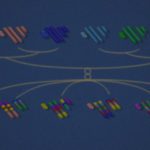Link to Pubmed [PMID] – 8752833
J. Invest. Dermatol. 1996 Jul; 107(1): 20-5
A new autosomal recessive mutation of the house mouse developed generalized alopecia associated with breakage of abnormal hair shafts. This mutation, named ‘lanceolate hair’ (symbol: lah), arose in a mutagenesis experiment using ethylnitrosourea. Hair shafts were short with a focal degeneration at the breakpoint characterized by a pronounced enlargement at the apex, resembling a lance head. Plucked hair fibers were 2.0 to 3.5 mm in length with a normal base, suggesting that there was a synchronized developmental defect. Histologic examination of anagen follicles revealed abnormal cornification of the matrix region with degeneration resulting in the focal hair shaft deformity. Catagen follicles showed pronounced follicular dystrophy but telogen follicles were almost normal. There was a marked, persistent thickening of the epidermis associated with a non-scarring, relatively non-inflammatory ichthyosiform dermatitis. These features are found in the Netherton’s syndrome of the human, for which this mouse mutation may represent a model. The lah mutation has been localized to the centromeric end of mouse Chromosome 18.

